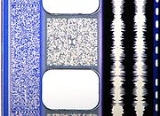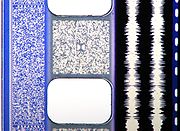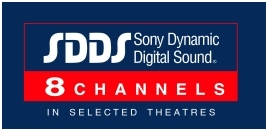
SDDS
Encyclopedia

Movie theater
A movie theater, cinema, movie house, picture theater, film theater is a venue, usually a building, for viewing motion pictures ....
sound
Sound
Sound is a mechanical wave that is an oscillation of pressure transmitted through a solid, liquid, or gas, composed of frequencies within the range of hearing and of a level sufficiently strong to be heard, or the sensation stimulated in organs of hearing by such vibrations.-Propagation of...
system developed by Sony
Sony
, commonly referred to as Sony, is a Japanese multinational conglomerate corporation headquartered in Minato, Tokyo, Japan and the world's fifth largest media conglomerate measured by revenues....
. Compressed digital sound information is recorded on both outer edges of the 35 mm film
35 mm film
35 mm film is the film gauge most commonly used for chemical still photography and motion pictures. The name of the gauge refers to the width of the photographic film, which consists of strips 35 millimeters in width...
release print. The system supports up to eight independent channels of sound: five front channels, two surround channels and a single sub-bass channel. The eight channel arrangement is similar to large format film
70 mm film
70mm film is a wide high-resolution film gauge, with higher resolution than standard 35mm motion picture film format. As used in camera, the film is wide. For projection, the original 65mm film is printed on film. The additional 5mm are for magnetic strips holding four of the six tracks of sound...
magnetic sound formats like Cinerama
Cinerama
Cinerama is the trademarked name for a widescreen process which works by simultaneously projecting images from three synchronized 35 mm projectors onto a huge, deeply-curved screen, subtending 146° of arc. It is also the trademarked name for the corporation which was formed to market it...
and Cinemiracle
Cinemiracle
Cinemiracle was a widescreen cinema format competing with Cinerama developed in the 1950s. It was ultimately unsuccessful, with only a single film produced and released in the format. Like Cinerama it used 3 cameras to capture a 2.59:1 image. Cinemiracle used two mirrors to give the left and right...
. The five front channels are useful for very large cinema auditoriums where the angular distance between center and left channels may be considerable. SDDS decoders provides the ability to downmix to fewer channels if required.
History
Although originally slated to premier with HookHook (film)
Hook is a 1991 American fantasy film directed by Steven Spielberg. The film stars Robin Williams, Dustin Hoffman, Julia Roberts, Bob Hoskins, and features Maggie Smith, Caroline Goodall, Charlie Korsmo, Amber Scott, and Dante Basco. Hook acts as a sequel to Peter Pan's original adventures, focusing...
, the SDDS project was delayed and instead premiered on June 17, 1993 with the Arnold Schwarzenegger
Arnold Schwarzenegger
Arnold Alois Schwarzenegger is an Austrian-American former professional bodybuilder, actor, businessman, investor, and politician. Schwarzenegger served as the 38th Governor of California from 2003 until 2011....
film Last Action Hero
Last Action Hero
Last Action Hero is a 1993 American action-comedy-fantasy film directed and produced by John McTiernan. It is a satire of the action genre and its clichés, containing several parodies of action films in the form of films within the film....
. Since then, over 1,400 movies have been mixed in Sony Dynamic Digital Sound, and as of early 1999 over 6,750 movie theaters were equipped with SDDS.
The code name for the SDDS project was "Green Lantern", taken from the name of the comic book hero
Green Lantern
The Green Lantern is the shared primary alias of several fictional characters, superheroes appearing in comic books published by DC Comics. The first Green Lantern was created by writer Bill Finger and artist Martin Nodell in All-American Comics #16 .Each Green Lantern possesses a power ring and...
and the old term of "magic lantern
Magic lantern
The magic lantern or Laterna Magica is an early type of image projector developed in the 17th century.-Operation:The magic lantern has a concave mirror in front of a light source that gathers light and projects it through a slide with an image scanned onto it. The light rays cross an aperture , and...
" used to describe the original projected pictures in the late 19th century. Green came to mind because the key to imprinting the 8 micrometre
Micrometre
A micrometer , is by definition 1×10-6 of a meter .In plain English, it means one-millionth of a meter . Its unit symbol in the International System of Units is μm...
data bits was to use a green laser.
Initial development efforts were conducted for Sony's Columbia Pictures
Columbia Pictures
Columbia Pictures Industries, Inc. is an American film production and distribution company. Columbia Pictures now forms part of the Columbia TriStar Motion Picture Group, owned by Sony Pictures Entertainment, a subsidiary of the Japanese conglomerate Sony. It is one of the leading film companies...
Sound Department under contract with Semetex Corp. of Torrance, California
Torrance, California
Torrance is a city incorporated in 1921 and located in the South Bay region of Los Angeles County, California, United States. Torrance has of shore-front beaches on the Pacific Ocean, quieter and less well-known by tourists than others on the Santa Monica Bay, such as those of neighboring...
. At Semetex, the SDDS Chief Architect was Jaye Waas and the Chief Optical Engineer was Mark Waring.
The Semetex prototype design actually had the 8 channels of uncompressed data placed into 3 locations: data bordering both sides of the analog sound track and additional data tracks bordering the opposite edge of the picture frame. These locations were chosen to ensure the data were not placed into the sprocket perforation area of the film to prevent the known wear and degradation that occurs in the perforation area (due to the mechanical film sprockets) from degrading the data. After Sony received the prototype they enlarged the data bits and moved the data locations; the eight digital audio channels are now recorded on (and recovered from) the edges of the film. As Sony engineers became more actively involved in the project, the design of the SDDS format evolved toward a more robust implementation, including the use of 5:1 ATRAC data compression, extensive error detection and correction, and most critically redundancy. The redundancy allows data to be recovered substantially intact even in the presence of a film splice. The data bit size on film was enlarged from 8 to 24 micrometers square, and Semetex's green laser system for the sound camera was replaced with simpler LED/fiber optic assemblies, which the change to 24 micrometers square then allowed.
The SDDS development took just 11 months from concept to working sound camera.
When it came time for deployment, since Sony also owned the Sony Theatres chain (later sold to Loews Theatres), it was able use SDDS in its own theatres. And via its highly successful Columbia/Tristar Studios arm, it was able to use SDDS as the exclusive digital soundtrack on its titles. In addition, in the early days of the "megaplex explosion", Sony struck a deal with AMC Theatres
AMC Theatres
AMC Theatres , officially known as AMC Entertainment, Inc., is the second largest movie theater chain in North America with 5,325 screens, second only to Regal Entertainment Group, and one of the United States's four national cinema chains AMC Theatres (American Multi-Cinema), officially known as...
in 1994 to include SDDS in all of their new auditoriums. This gave SDDS a much needed, albeit artificial, kick-start. More than likely it would have garnered far less penetration had Sony not controlled both a theatre chain and a film studio.
SDDS was consistently the least popular of the three competing digital sound formats (the other two being Dolby Digital
Dolby Digital
Dolby Digital is the name for audio compression technologies developed by Dolby Laboratories. It was originally called Dolby Stereo Digital until 1994. Except for Dolby TrueHD, the audio compression is lossy. The first use of Dolby Digital was to provide digital sound in cinemas from 35mm film prints...
(aka SRD) and DTS). Along with being the most expensive to install (and the last to arrive), there were major reliability issues with SDDS. Due to their placement on the very edges of the film stock, SDDS tracks are more prone to damage than the other digital formats. As with other digital sound formats, any failure of the digital track will result in a "drop-out" to either another digital format if available, or (most likely) to analog sound. These drop-outs are audible to audiences as a change in volume level and a slight loss of fidelity and extreme high and low-end, similar to a "CD skipping", although it is more difficult to tell in a properly calibrated auditorium.
SDDS's much-touted eight track playback capability never quite caught on, as it required that a separate eight channel sound mix be created in addition to the six channel mix that is needed for SRD and DTS, an additional expense for the studios. Out of the 1,400 plus films mixed in SDDS, only 97 of them to date have been mixed to support the full 8 channels, most of them Sony (Via Sony Pictures/Columbia/Tristar) releases. Because of the added installation expense, the majority of SDDS installations are 6 channel (5.1) installations, as opposed to 8 channel (7.1) installations.
- See also List of 8 channel SDDS films.

While most major studios eventually began putting SDDS tracks on their releases (Universal exclusively supported DTS until 1998, and Paramount and Fox placed SDDS tracks on only their biggest releases until 2001-2002), most independent films only came with Dolby Digital tracks, leaving many SDDS-equipped theaters playing analog sound in otherwise state-of-the-art auditoriums. As Dolby Digital (and to a lesser degree, DTS) began to emerge as the clear winner in the digital sound battle, Sony Cinema Products quit manufacturing SDDS encoders and decoders, although it will continue supporting equipment that is still deployed in the field.
Today, a majority of release prints for major studio films still are created with all three digital tracks -- Dolby Digital
Dolby Digital
Dolby Digital is the name for audio compression technologies developed by Dolby Laboratories. It was originally called Dolby Stereo Digital until 1994. Except for Dolby TrueHD, the audio compression is lossy. The first use of Dolby Digital was to provide digital sound in cinemas from 35mm film prints...
, DTS
Digital Theater System
DTS is a series of multichannel audio technologies owned by DTS, Inc. , an American company specializing in digital surround sound formats used for both commercial/theatrical and consumer grade applications...
and Sony's SDDS (each digital track uses different film geography so all three, as well as the analog track, can coexist on one print) -- but most professionals in the industry now consider SDDS a dying system. AMC, for example, has begun to replace their SDDS equipment with Dolby Digital processors.
Technical
_label.svg.png)
- Original format used: 8 micrometre square data bits.
- Final format used: 24 micrometre square data bits.
The format carries up to 8 channels of discrete digital sound encoded using Sony's ATRAC codec with a compression ratio of about 5:1 and a sampling rate of 44.1 kHz. The channels are:
- 5 screen channels
- Left
- Left center
- Center
- Right center
- Right
- 2 surround channels
- Left surround
- Right surround
- Subwoofer channel
Additionally there are 4 backup channels encoded - in case of damage to one side of the film or the other. These are:
- Center
- Subwoofer
- Left + left center
- Right + right center
This gives a total of 12 channels, for which the total bitrate of 2.2 megabits per second. This is obviously more than the maximum 1.536 megabits per second DTS
Digital Theater System
DTS is a series of multichannel audio technologies owned by DTS, Inc. , an American company specializing in digital surround sound formats used for both commercial/theatrical and consumer grade applications...
format bitrate, and far greater than the cinema Dolby Digital
Dolby Digital
Dolby Digital is the name for audio compression technologies developed by Dolby Laboratories. It was originally called Dolby Stereo Digital until 1994. Except for Dolby TrueHD, the audio compression is lossy. The first use of Dolby Digital was to provide digital sound in cinemas from 35mm film prints...
bitrate of 0.37 megabits per second.
For additional data reliability the two sides of the film are separated by 17 frames, so a single splice or series of missing frames will not result in a total loss of data.
Reader
The SDDS reader is mounted on top of a 35mm projectorMovie projector
A movie projector is an opto-mechanical device for displaying moving pictures by projecting them on a projection screen. Most of the optical and mechanical elements, except for the illumination and sound devices, are present in movie cameras.-Physiology:...
. The film is threaded through the reader before it passes through the picture aperture. As the film runs, red LEDs are used to illuminate the SDDS soundtrack
Soundtrack
A soundtrack can be recorded music accompanying and synchronized to the images of a motion picture, book, television program or video game; a commercially released soundtrack album of music as featured in the soundtrack of a film or TV show; or the physical area of a film that contains the...
. CCDs (Charge-Coupled Devices
Charge-coupled device
A charge-coupled device is a device for the movement of electrical charge, usually from within the device to an area where the charge can be manipulated, for example conversion into a digital value. This is achieved by "shifting" the signals between stages within the device one at a time...
) read the SDDS data and convert the stream of dots on the film into digital information. This information is pre-processed in the reader and passed on to the SDDS decoder.
Decoder
The SDDS decoderDecoder
A decoder is a device which does the reverse operation of an encoder, undoing the encoding so that the original information can be retrieved. The same method used to encode is usually just reversed in order to decode...
is installed in the sound equipment rack. The decoder receives the information from the reader and translates it into audio
Sound
Sound is a mechanical wave that is an oscillation of pressure transmitted through a solid, liquid, or gas, composed of frequencies within the range of hearing and of a level sufficiently strong to be heard, or the sensation stimulated in organs of hearing by such vibrations.-Propagation of...
signals routed to the cinema's power amplifiers. The decoder is responsible for a series of processes that must be performed before the audio is recovered. Next, errors caused by scratches or damage to the film are corrected using redundant error recovery data. Since SDDS is read at the top of the projector, the data is delayed slightly to restore synchronization with the picture. And finally, adjustments in tonal balance and playback level are made to match the specific auditorium's sound system and acoustics. SDDS is designed to process sound entirely in the digital domain, bypassing any existing analog processor, preserving clarity and providing full dynamic range.

